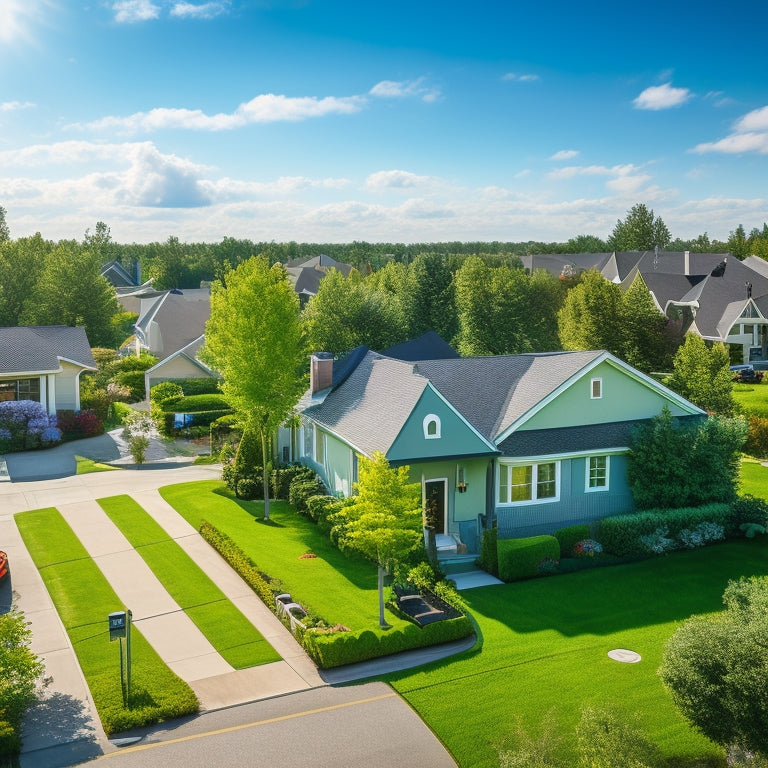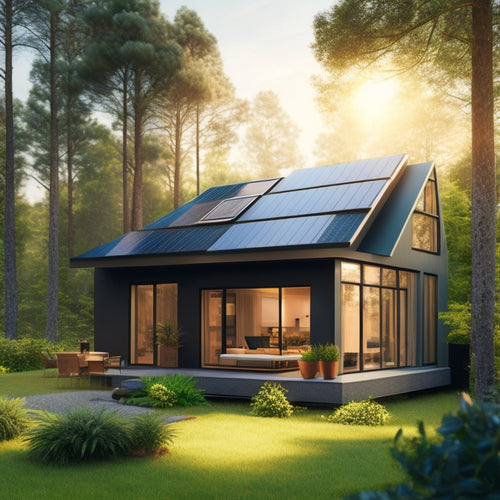
How to Get the Best Average Savings With Solar Panels
Share
To get the best average savings with solar panels, you'll want to start by understanding your energy consumption patterns and identifying areas of inefficiency. Then, choose the right solar panel for your needs, balancing energy output with budget and roof size. Optimize your system design for maximum energy production, and don't forget to position panels at the ideal angle and direction. Regular maintenance, like cleaning and monitoring, is also essential. By following these steps, you can maximize your energy savings, with the average American household saving around $400 to $1,000 per year. Now, take the next step to uncover the full potential of your solar panel investment.
Key Takeaways
- Conduct an energy audit to identify peak usage times and seasons, and determine necessary solar panel system size for optimal savings.
- Choose the right solar panel type based on efficiency, installation costs, and energy needs to maximize energy output per area.
- Optimize system design for maximum energy output, considering installation costs, solar incentives, and ideal panel angle and direction.
- Regularly clean panels every 6-12 months and maintain system cleanliness to prevent energy losses and ensure optimal performance.
- Monitor system performance in real-time using tracking tools and schedule annual professional inspections to identify potential issues early.
Understanding Your Energy Consumption
Determine your energy consumption patterns to get the most out of your solar panel investment.
Conducting an energy audit is essential to understanding your energy usage habits. This involves tracking your energy consumption over a specific period, typically a year, to identify patterns and areas of inefficiency.
You'll want to analyze your energy bills, noting the time of day and year when you use the most energy. This information will help you determine the size and type of solar panel system you need to meet your energy demands.
Choosing the Right Solar Panel
Now that you've got a handle on your energy consumption patterns, you're ready to select the right solar panel for your needs. With various panel types available, it's crucial to evaluate factors like efficiency, durability, and cost. Here's a breakdown of popular panel types to help you make an informed decision:
| Panel Type | Efficiency | Installation Costs |
|---|---|---|
| Monocrystalline | 15-20% | $2.50-$3.50 per watt |
| Polycrystalline | 12-15% | $2.20-$3.20 per watt |
| Thin-Film | 7-14% | $1.50-$2.50 per watt |
| Bifacial | 18-22% | $3.00-$4.00 per watt |
| PERC | 18-22% | $2.80-$3.80 per watt |
When choosing a solar panel, assess your energy needs, roof size, and budget. While more efficient panels may cost more, they can provide higher energy output per unit area. On the other hand, less efficient panels might be more cost-effective but require more space. By balancing these factors, you can select the right solar panel for your needs and maximize your average savings.
Optimizing Your Solar Panel System
Step up your solar game by fine-tuning your panel system to squeeze out the maximum energy output. Enhancing your solar panel system is vital to get the best average savings. When you're investing in solar, you want to confirm you're getting the most bang for your buck.
To do this, consider the installation costs and how they can impact your overall savings. Look for solar incentives that can help offset these costs, such as federal and state tax credits, rebates, and net metering programs.
Next, focus on the system's design and configuration. Verify your panels are installed at the ideal angle and direction to capture the most sunlight.
Consider using a monitoring system to track your energy production and identify areas for improvement. Additionally, make sure your system is properly maintained to prevent energy losses due to dirt, debris, or technical issues.
Maximizing Energy Production Capacity
Your solar panel system's energy production capacity is only as good as its ability to capture the sun's energy. To maximize this capacity, you need to verify your system is installed at the ideal angle and direction to receive direct sunlight.
A thorough site assessment will help identify the best location for your solar panels, considering any obstructions or shading issues. Additionally, contemplate investing in energy storage solutions, such as batteries, to store excess energy generated during the day for use during periods of low sunlight or at night. This will empower you to maximize your energy production capacity and reduce your reliance on the grid.
Moreover, verify that your solar panels are free from debris and dirt, which can reduce their energy output. By enhancing your solar panel system's energy production capacity, you'll be able to generate more power and increase your savings.
Monitoring and Maintaining Efficiency
Regularly, your solar panel system requires attention to maintain its peak performance and efficiency.
You need to keep a close eye on its operation to identify potential issues before they affect your energy savings. This is where monitoring tools come in. By utilizing these tools, you can track your system's performance in real-time, receiving alerts and notifications when something goes awry.
To maintain your system's efficiency, follow these maintenance tips:
-
Clean your panels regularly: Dirt, dust, and debris can reduce your system's energy output by up to 25%. Clean your panels every 6-12 months to guarantee optimal performance.
-
Check for loose connections: Loose connections can cause energy losses and even lead to system failure. Inspect your system regularly to verify all connections are secure.
-
Inspect for shading: Shading can greatly reduce your system's energy output. Trim trees and remove any obstructions to confirm your panels receive maximum sunlight.
- Perform annual inspections: Hire a professional to inspect your system annually to identify potential issues before they become major problems.
Frequently Asked Questions
Can I Install Solar Panels on My Roof if It's Shaded?
You can install solar panels on a shaded roof, but it'll reduce energy output. Shaded roofs pose installation challenges, so you'll need to assess the extent of shading and potentially use specialized equipment or designs to maximize energy production.
Do Solar Panels Still Work During Power Outages?
When the grid goes dark, you're left in the dark, but not with solar panels. You'll stay lit, as long as you've got a backup battery system to store excess energy, ensuring your solar panel efficiency isn't lost during power outages.
Are Solar Panels Resistant to Extreme Weather Conditions?
You'll be relieved to know that modern solar panels are designed to withstand extreme weather conditions, boasting impressive durability. They can resist hail, high winds, and heavy snowfall, ensuring minimal weather impact on their performance and longevity.
Can I Sell Excess Energy Back to the Grid?
You can sell excess energy back to the grid through net metering benefits, where utilities measure your production and consumption, crediting you for the excess, or through energy buyback programs, which purchase your surplus energy at a set rate.
Do Solar Panels Increase My Property's Value?
You'll likely see an increase in your property's value with solar panels, as they increase appeal to potential buyers; plus, you'll benefit from property tax benefits and attractive solar financing options, making your investment even more lucrative.
Related Posts
-

Top 7 Portable Solar Car Battery Solutions Online
You're in luck with our selection of reliable portable solar car battery solutions that meet your needs and budget. O...
-

What Role Do Unicycles Play in Urban Transport?
As you navigate through congested city streets, unicycles emerge as a viable solution, slashing carbon emissions by u...
-

Reduce Solar Panel Cost for Your Small Home
By evaluating your energy needs, choosing the right installer, and selecting cost-effective solar panel options, you ...


